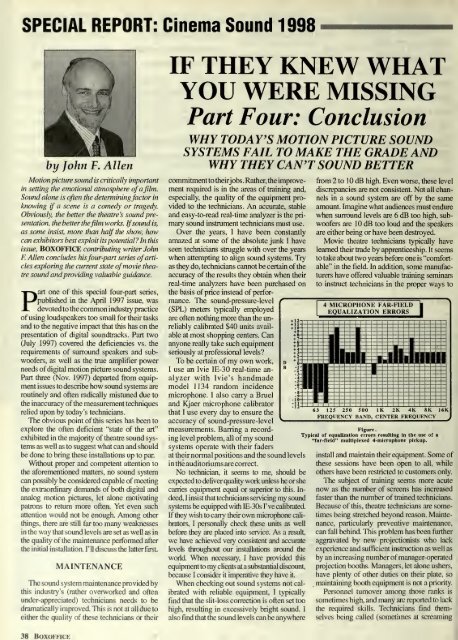Create successful ePaper yourself
Turn your PDF publications into a flip-book with our unique Google optimized e-Paper software.
SPECIAL REPORT: Cinema Sound 1998<br />
hy John F. Allen<br />
Motion picture sound is critically important<br />
in setting the emotional atmosphere ofa film.<br />
Sound alone is often the determiningfactor in<br />
knowing if a scene is a comedy or tragedy.<br />
Obviously, the better the theatre's sowxd presentation,<br />
the better thefilm works. Ifsound is,<br />
as some insist, more than half the show, how<br />
can exhibitors best exploit itspotential? In this<br />
issue, BOXOFFICE contributing writer John<br />
F. Allen concludes hisfour-part series ofarticles<br />
exploring the current state ofmovie theatre<br />
sound andproviding valuable guidance.<br />
Part<br />
one of this special four-part series,<br />
published in the April 1997 issue, was<br />
devoted to the common industry practice<br />
of using loudspeakers too small for their tasks<br />
and to the negative impact that this has on the<br />
presentation of digital soundtracks. Part two<br />
(July 1997) covered the deficiencies vs. the<br />
requirements of surround speakers and subwoofers,<br />
as well as the true amplifier power<br />
needs of digital motion picture sound systems.<br />
Part three (Nov. 1997) departed from equipment<br />
issues to describe how sound systems are<br />
routinely and often radically mistuned due to<br />
the inaccuracy of the measurement techniques<br />
relied upon by today's technicians.<br />
The obvious point of this series has been to<br />
explore the often deficient "state of the art"<br />
exhibited in the majority of theatre sound systems<br />
as well as to suggest what can and should<br />
be done to bring these installations up to par.<br />
Without proper and competent attention to<br />
the aforementioned matters, no sound system<br />
can fxjssibly be coasidered capable of meeting<br />
the extraordinary demands of both digital and<br />
analog motion pictures, let alone motivating<br />
patrons to return more often. Yet even such<br />
attention would not be enough. Among other<br />
things, there are still far too many weaknesses<br />
in the way that sound levels are set as well as in<br />
the quality of the maintenance performed after<br />
the initial in.stallation. I'll discuss the latterfirst.<br />
MAINTENANCE<br />
The sound system maintenance provided by<br />
this industry's (rather overworked and often<br />
under-appreciated) technicians needs to be<br />
dramatically improved. This is not at all due to<br />
either the quality of these technicians or their<br />
IF THEY KNEW WHAT<br />
YOU WERE MISSING<br />
Part Four: Conclusion<br />
WHY TODAY'S MOTION PICTURE SOUND<br />
SYSTEMS FAIL TO MAKE THE GRADE AND<br />
WHY THEY CAN'T SOUND BETTER<br />
commitment to theirjobs. Rather, the improvement<br />
required is in the areas of training and,<br />
especially, the quality of the equipment provided<br />
to the technicians. An accurate, stable<br />
and easy-to-read real-time analyzer is the primary<br />
sound instrument technicians must use.<br />
Over the years, I have been constantly<br />
amazed at some of the absolute junk I have<br />
seen technicians struggle with over the years<br />
when attempting to align sound systems. Try<br />
as they do, technicians cannot be certain of the<br />
accuracy of the results they obtain when their<br />
real-time analyzers have been purchased on<br />
the basis of price instead of performance.<br />
The sound-pressure-level<br />
(SPL) meters typically employed<br />
are often nothing more than the unreliably<br />
calibrated $40 units available<br />
at most shopping centers. Can<br />
anyone really take such equipment<br />
seriously at professional levels?<br />
To be certain of my own work,<br />
I use an Ivie IE-30 real-time analyzer<br />
with Ivie's handmade<br />
model 1134 random incidence<br />
microphone. I also carry a Bruel<br />
and Kjaer microphone caUbrator<br />
that I use every day to ensure the<br />
accuracy of sound-pressure-level<br />
measurements. Barring a recording<br />
level problem, all of my sound<br />
systems operate with their faders<br />
at their normal positions and the sound levels<br />
in the auditoriums are correct.<br />
No technician, it seems to me, should be<br />
expected to deliver quality work unless he or she<br />
carries equipment equal or superior to this. Indeed,<br />
I insist that technicians servicing my sound<br />
.systems be equipped with IE-30s I've calibrated.<br />
If they wish to carry their own microphone calibrators,<br />
I personally check these units as weU<br />
before they are placed into service. As a result,<br />
we have achieved very consistent and accurate<br />
levels throughout our installations around the<br />
world. When necessary, I have provided this<br />
equipment to my clients at a substantial disanint,<br />
becau,se I consider it imperative they have it<br />
When checking out sound systems not calibrated<br />
with reliable equipment, I typically<br />
find that the slit-loss correction is often set too<br />
high, resulting in excessively bright sound. I<br />
also find that the sound levels can be anywhere<br />
from 2 to 10 dB high. Even worse, these level<br />
discrepancies are not consistent. Not all channels<br />
in a sound system are off by the same<br />
amount. Imagine what audiences must endure<br />
when surround levels are 6 dB too high, subwoofers<br />
are 10 dB too loud and the speakers<br />
are either being or have been destroyed.<br />
Movie theatre technicians typically have<br />
learned their trade by apprenticeship. It seems<br />
to take about two years before one is "comfortable"<br />
in the field. In addition, some manufacturers<br />
have offered valuable training seminars<br />
to instruct technicians in the proper ways to

















